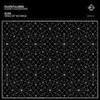Eleh/Ellen Fullman
 Out of the two latest Eleh releases, this split LP with Ellen Fullman comes out as the champion. Here are two sides of stunning contemporary minimalism; Eleh pushes about electrons like a quantum choreographer while Fullman pulls tones out of metal with her fingers. Both pieces are engaging and despite their differences in execution, they complement each other like two lovers in union.
Out of the two latest Eleh releases, this split LP with Ellen Fullman comes out as the champion. Here are two sides of stunning contemporary minimalism; Eleh pushes about electrons like a quantum choreographer while Fullman pulls tones out of metal with her fingers. Both pieces are engaging and despite their differences in execution, they complement each other like two lovers in union.
 
On "Mind of No Mind," Eleh develops their compositional approach further out than before. In comparison to the La Monte Young and Pauline Oliveros worship of earlier releases, this piece is practically a pop song. A warm, meditative wave of synthesizer rolls out of the speakers before breaking into rivulets of calming pulses. It all sounds a bit new age but there is substance lurking below the surface. As the piece progresses, the influence of more modern explorations of minimalism like Ryoji Ikeda and Alva Noto peeps through; the beats that emerge from the obsidian drones come as a shock. It is not like such sounds are new to Eleh but the prominence of these sounds changes the character of the piece instantly. What was a monochrome sea of sound is suddenly alive, a Cambrian explosion of music.
Flipping the record over, Fullman’s "Event Locations" shows how the ideas explored by the minimalist composers of the 1960s can still bear sweet fruit. Her Long String Instrument, a gorgeous sculpture capable of generating a range of sounds in just intonation, forms the flesh of this particular fruit. Bowing the strings with her fingers, Fullman creates a swirling mass of tones. The combined effect creates something between a hurdy gurdy, accordion and bells. As she moves through the piece, the interaction between the notes cause audio disturbances and fleeting ghosts in the music.
Along with the Attention Patterns compilation (also reviewed this week), this LP represents the best in an often abused form of composition. Many artists retreat to a minimalist-like style to escape poor technique and a lack of imagination but both Eleh and Fullman show how minimalist theory can still be used to create commanding works that could never be classed as derivative or unskilled.
 



